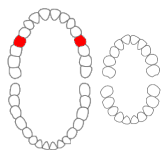Location and Function
- Maxillary second premolars are located in the upper maxilla.
- They are positioned laterally from the maxillary first premolars.
- These teeth are mesial to the maxillary first molars.
- The primary function of maxillary second premolars is grinding during mastication.
- They contribute to the chewing process.
Anatomy
- Maxillary second premolars have two cusps.
- The cusps are less sharp compared to the cusps of maxillary first premolars.
- There are no deciduous maxillary premolars.
- Instead, deciduous maxillary molars precede the permanent maxillary premolars.
- The anatomy of maxillary second premolars differs from other teeth in the mouth.
Notation Systems
- In the universal system of notation, the right maxillary second premolar is designated as 4, and the left one as 13.
- Palmer notation uses a number and symbol to identify the quadrant and tooth type.
- The right and left maxillary second premolars in Palmer notation are both labeled as 5, but with different symbols.
- The international notation assigns the right maxillary second premolar as 15, and the left one as 25.
- Different notation systems exist to identify maxillary second premolars.
References
- Ash, Major M. and Stanley J. Nelson (2003). Wheeler's Dental Anatomy, Physiology, and Occlusion. 8th edition.
- The referenced book provides detailed information about dental anatomy, including maxillary second premolars.
- Understanding dental anatomy is essential for dental professionals.
- The book covers various aspects of dental physiology and occlusion.
- Wheeler's Dental Anatomy is a reputable source for dental education.
Additional Information
- Maxillary second premolars are part of the permanent dentition.
- There are no premolars in the primary (baby) teeth.
- The grinding action of maxillary second premolars aids in the breakdown of food.
- The shape and structure of maxillary second premolars contribute to their function.
- Studying dental anatomy helps in identifying and treating dental conditions.
The maxillary second premolar is one of two teeth located in the upper maxilar, laterally (away from the midline of the face) from both the maxillary first premolars of the mouth but mesial (toward the midline of the face) from both maxillary first molars. The function of this premolar is similar to that of first molars in regard to grinding being the principal action during mastication, commonly known as chewing. There are two cusps on maxillary second premolars, but both of them are less sharp than those of the maxillary first premolars. There are no deciduous (baby) maxillary premolars. Instead, the teeth that precede the permanent maxillary premolars are the deciduous maxillary molars.
| Maxillary second premolar | |
|---|---|
 Maxillary second premolars of permanent teeth marked in red. There are no premolars in primary teeth. | |
| Identifiers | |
| FMA | 55802 |
| Anatomical terminology | |
In the universal system of notation, the permanent maxillary premolars are designated by a number. The right permanent maxillary second premolar is known as "4", and the left one is known as "13". In the Palmer notation, a number is used in conjunction with a symbol designating in which quadrant the tooth is found. For this tooth, the left and right second premolars would have the same number, "5", but the right one would have the symbol, "┘", underneath it, while the left one would have, "└". The international notation has a different numbering system than the previous two, and the right permanent maxillary second premolar is known as "15", and the left one is known as "25".